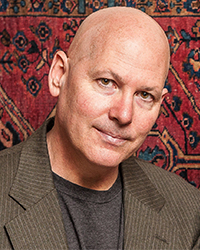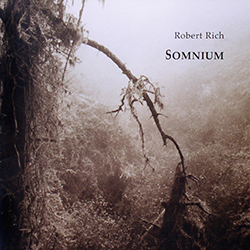In the previous few articles, it may seem as though i’ve been avoiding the very obvious elephant in the room. So let’s confront it now: large-scale musical ‘epics’ of the kind i’ve been exploring present formidable problems to the listener. Assuming one can find the time to devote to it, there’s the issue of focus, of trying to maintain some semblance of concentration for a very much longer-than-usual period of time; furthermore, attempting to hear each passing event within the wider context of the whole (rather than just listening superficially) becomes a strenuous and potentially unwieldy activity. i accept that these are very real challenges with such music, and while i can speak from experience and state that it’s something that becomes much less of a problem the more one becomes acquainted with large-scale music, the fourth ‘contemporary epic’ i’d like to examine is a work that could be said to tackle the reality of this situation head-on—or, at least, take a fundamentally different approach to it.
 The composer Robert Rich established his reputation in the early 1980s, as a composer whose live performances took place through the night. In part they were concerts, yet more importantly to Rich they were experiments, investigating the ways in which sound can stimulate periods of REM sleep. At these events, the audience would take its place on the floor, actively encouraged—and this may sound paradoxical—to interact with Rich’s performance through the act of sleep, engaging with the music through the gauze of a semi-conscious mind. These “sleep concerts” directly influenced the albums Rich released around this time; his debut album Sunyata (1982) pared down its content to a minimum—echoing the title, which is a Buddhist concept approximating to ’emptiness’ or ‘void’—while at the same time greatly expanding its duration to better facilitate a meditative listening state (originally released on cassette, the album was unusual at lasting almost 86 minutes). The titles of his next two albums, Trances and Drones (both 1983), made explicit the kind of deeply subliminal interrelationship Rich wanted his music to have with its audience, whether experienced live or at home.
The composer Robert Rich established his reputation in the early 1980s, as a composer whose live performances took place through the night. In part they were concerts, yet more importantly to Rich they were experiments, investigating the ways in which sound can stimulate periods of REM sleep. At these events, the audience would take its place on the floor, actively encouraged—and this may sound paradoxical—to interact with Rich’s performance through the act of sleep, engaging with the music through the gauze of a semi-conscious mind. These “sleep concerts” directly influenced the albums Rich released around this time; his debut album Sunyata (1982) pared down its content to a minimum—echoing the title, which is a Buddhist concept approximating to ’emptiness’ or ‘void’—while at the same time greatly expanding its duration to better facilitate a meditative listening state (originally released on cassette, the album was unusual at lasting almost 86 minutes). The titles of his next two albums, Trances and Drones (both 1983), made explicit the kind of deeply subliminal interrelationship Rich wanted his music to have with its audience, whether experienced live or at home.
The most telling example of this is his magnum opus Somnium, released in 2001. Having alluded to the nature of the “sleep concerts” through a prolific series of albums, on Somnium Rich sought to return to the source and directly replicate that experience. The only way to do that faithfully was for the music to be heard right through the night; hence the reason for Somnium‘s massive duration, lasting a little over seven hours. So Somnium presents the listener with the ultimate challenge, a work of unprecedented length, but it also presents its own solution, stated clearly in the title, inviting its audience to experience it through sleep. In the accompanying notes, Rich helpfully elucidates on the nature of that interaction:
The term “Sleep Concert” can be a bit misleading, as it implies that this music is intended to help you sleep deeply. On the contrary, when you play Somnium at night, you may find that you sleep less deeply, and wake up more often. The idea is to let the music incorporate itself into your perceptual framework during the night, to create a sonic surround, an environment for unique states of consciousness. The music is aimed at the nebulous territory that exists in your mind when you are hovering between awake and asleep, when you are still aware of your environment, yet detached, when your half-sleeping mind wanders into the realm of hypnogogic images and dreamlike non-linearity. You might find that this music can act as a trigger for these flowing thoughts, and the activation of the environment around you can help you to skate around the edges of sleep, with one foot in the dream world and one foot in the room where you are sleeping.
 While Somnium occupies a vast, single durational span, it does pass through three distinct periods: into, during, and out from the period of REM sleep. To that end, the outer parts (which each last 2½ hours) are profoundly gentle, a warm cushion characterised by soft-edged chords slowly drifting in space, shifting from one formation to another. That’s not to suggest the music is aimless—on the contrary, despite requiring a different kind of perspective, they are in fact overtly functional, with a clear sense of direction towards and away from the crucial central period. Unsurprisingly, though, speed of movement throughout is infinitessimal; an Eastern flute, heard prominently at the beginning of Part 1, takes 20 minutes to be absorbed into a chord that oscillates on its axis, and a further 20 minutes pass while that chord loses its substance, leaving nothing but a deep drone and soft amphibian noises. Deep clusters throb, becoming a solid slab, hovering massively; it drifts further away, yet still sends out a shuddering bass that seems to probe the ears. Water sounds feature both here and throughout Somnium; the work begins with light rain, and assorted trickles and droplets are a recurring idea. Both the conclusion of Part 1 and much of the first half of Part 3 are ostensibly static, the former ebbing away into an indistinct and hollow place, coloured with wind, the latter focusing on chords seemingly reluctant to stir (although their surfaces bristle with life), yet ever feeling as though they might move at any moment. The second half of Part 3, returning gradually to conscious reality, includes a potent sequence of pulses resonating in the depths, and reintroduces the bird and animal calls from earlier; they predominate towards the conclusion, conjuring up (and, if heard through the night, literally accompanying) the sounds of morning.
While Somnium occupies a vast, single durational span, it does pass through three distinct periods: into, during, and out from the period of REM sleep. To that end, the outer parts (which each last 2½ hours) are profoundly gentle, a warm cushion characterised by soft-edged chords slowly drifting in space, shifting from one formation to another. That’s not to suggest the music is aimless—on the contrary, despite requiring a different kind of perspective, they are in fact overtly functional, with a clear sense of direction towards and away from the crucial central period. Unsurprisingly, though, speed of movement throughout is infinitessimal; an Eastern flute, heard prominently at the beginning of Part 1, takes 20 minutes to be absorbed into a chord that oscillates on its axis, and a further 20 minutes pass while that chord loses its substance, leaving nothing but a deep drone and soft amphibian noises. Deep clusters throb, becoming a solid slab, hovering massively; it drifts further away, yet still sends out a shuddering bass that seems to probe the ears. Water sounds feature both here and throughout Somnium; the work begins with light rain, and assorted trickles and droplets are a recurring idea. Both the conclusion of Part 1 and much of the first half of Part 3 are ostensibly static, the former ebbing away into an indistinct and hollow place, coloured with wind, the latter focusing on chords seemingly reluctant to stir (although their surfaces bristle with life), yet ever feeling as though they might move at any moment. The second half of Part 3, returning gradually to conscious reality, includes a potent sequence of pulses resonating in the depths, and reintroduces the bird and animal calls from earlier; they predominate towards the conclusion, conjuring up (and, if heard through the night, literally accompanying) the sounds of morning.
But i find the more demonstrative 2-hour central period to be even more mesmeric. At first, there’s the sensation we’re heading into a territory of loops; not so, it develops into a deep, softly shimmering texture, from which a hint of melody yields to distant animal calls. Chords oscillate, feeling vast in a sonic space as infinite as this, taking new forms that bring to mind the consistency of galaxies. Rich doesn’t wrap his REM-based listener in aural cotton wool, though; metallic surges assert themselves, and pitches coalesce into a distinct 7th chord about halfway through. When added to by a rich, warm bass, the music becomes boldly substantial, even powerful—Rich may be concerned with sleep interaction, but Somnium is by no means seeking merely to tranquillise its audience with a 7-hour lullaby. The sound of the sea is introduced, matched with gentle dissonances, culminating in isolated metallic strikes—akin to Buddhist monastery bells—that cause deep ripples in the texture, passing into the final period with brief loud roars crashing like waves. It’s remarkable just how much Part 2 contrasts with its neighbours; at times—i don’t think this is exaggerating—it almost seems to be provocative (at least, to someone half-asleep).
Beyond this, it makes little or no sense to discuss Somnium‘s minutiæ; that’s not why they’re there, and in any case, when listened to as the composer intended, the amount of detail filtering through will vary from person to person and from occasion to occasion. For myself, i’ve listened to it through the night—glimpsing it as and when my fuzzy attention found something to grasp onto—and can testify to a uniquely fascinating trip (in every sense, that word seems right). and i’ve also listened to it ‘cold’, my attention raptly focused, and can honestly say i find it just as rewarding in this context too—except, of course, it makes for an entirely different experience. However one hears it, Somnium is a truly unique musical encounter.
When Somnium was first released, the only practicable format was DVD-audio; but even this was problematic, requiring that Part 2 be compressed in order to fit all the audio onto the disc. It’s fitting that in this 10th anniversary year Somnium has been reissued as a digital download; the lossless (FLAC) version represents the first time the piece has been heard in its original, uncompressed state—it’s thereby the best option, better even than the original DVD release. The download can be bought from Musiczeit here, and as usual there’s an MP3 option for those with poor hearing. The DVD can still be bought directly from Robert Rich here, where you can also read Rich’s extensive notes about the piece, as well as his advice for how best to listen to it. The DVD can also be bought from CD Baby, but it’s worth pointing out that the MP3 download available there is a drastically edited version, lasting a mere 73 minutes, barely a tenth of the original duration, and is therefore to be avoided.
